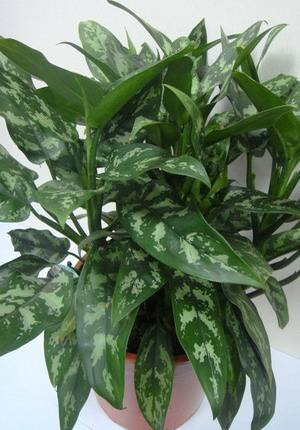
Aglaonema (Aglaonema) is a herbaceous, evergreen plant from the Aroid family (Araceae).
- Homeland: the islands of the Malay Archipelago and East India.
- Family: Araceae (Araceae).
- Content temperature: in winter not less than +16 +18°C, in summer +20 +25°C.
- Watering: plentiful in summer with mandatory moistening, moderate in winter, avoiding waterlogging and drying of the substrate.
- Flowering: June – August.
- Growth rate: average.
- Lighting: bright and diffused light for variegated forms and shading for plants with a monotonous leaf color.
Description: Aglaonema is a plant with an upright, short, fleshy stem, almost invisible in young plants, and with traces of fallen leaf bases in adults. On short or long petioles, the leaves are entire, leathery, dense, from oblong-lanceolate to broadly ovate, patterned with a depressed midrib protruding from the lower part of the leaf. The color of the leaves depends on the variety and type of crop.
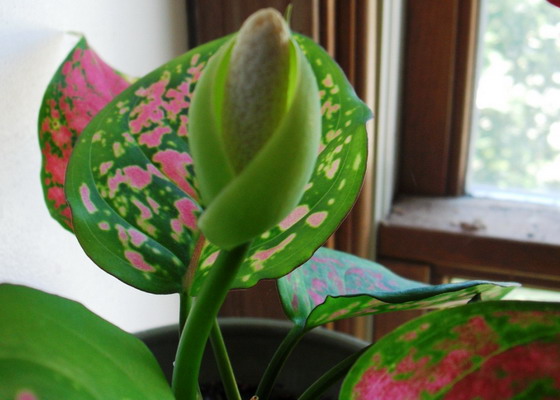
Flowering aglaonema in the photo
Aglaonema flower has an inflorescence – an ear with a greenish-white veil. Cobs develop in 1-3 pieces in the axils of the upper leaves, and depending on the type of plant, they are club-shaped, cylindrical and thin. The flowers are collected in a small cob, and after flowering, red berries appear on the plant.
Aglaonema is grown in greenhouses and rooms with moderate air temperature as an ornamental leafy plant. When in contact with the plant, precautions must be taken, as the juice and berries contain substances that irritate the skin.
Aglaonema – popular species
According to various sources, there are from 20 to 50 plant species, and the number of varieties and hybrids is about 500. Main Aglaonema species:
Aglaonema painted (Aglaonema pictum) – up to 60 cm high with a strongly branching stem below. Numerous shoots are abundantly covered with dark green leaves with grayish, rather large, uneven spots on the surface. Leaves up to 5 cm wide and up to 20 cm long, oblong-elliptical in shape. The fruit is red. It grows in tropical rainforests on the islands of Borneo and Sumatra.

Ribbed Aglaonema (Aglaonema costatum NE Br.) is a short, branched herbaceous plant from the tropical forests of Southwest Malaysia. The leaves are oval-ovate, green with white strokes and spots on the upper side, up to 20 cm long and up to 10 cm wide.
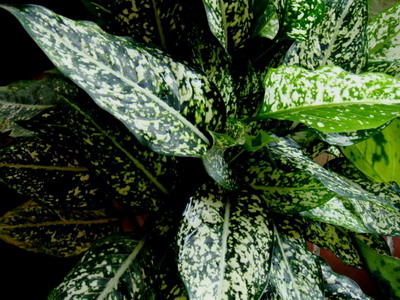
Aglaonema moderate or modest (Aglaonema modestum) – 40-50 cm tall with a branched stem. The leaves are oval, obtuse at the base, and pointed at the top 6-9 cm wide and 15-20 cm long, evenly green. The fruits are red, very similar to dogwood. It lives on the mountain slopes of the tropical forests of the Indochina Peninsula and the Malay Archipelago.

Variable or changeable Aglaonema (Aglaonema commutatum Schott) – with erect, from 20 to 150 cm tall stems and leaves on long petioles up to 30 cm long and 10 cm wide, pale green in color. The flowers are collected in inflorescences of 3-6 flowers. The fruit is a red berry. Homeland – Sulawesi, Philippines.

Shiny Aglaonema (Aglaonema nitidum Kunth) is a large plant with a stem up to 1 m tall and dark or bright green, shiny leaves on top up to 45 cm long and up to 20 cm wide. The fruits are white. Homeland – Sumatra, Kalimantan, Thailand, Malaysia.
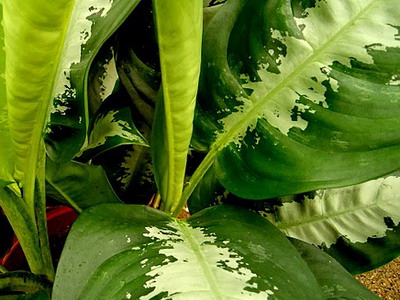
Aglaonema oblongata (Aglaonema marantifolium Blume) – grows in the tropical forests of the Philippines, Singapore and on the islands of Penang and Borneo. Large dark green leaves 25-30 cm long are located on long (20 cm) petioles. On the leaves of some varieties of the plant there is a silver-gray pattern.

What is the care for aglaonema?
Aglaonema: care involves keeping the plant in partial shade, direct sunlight is not allowed, as they will burn the leaves. But, variegated forms need bright diffused light so as not to lose the decorative pattern on the leaves.
The optimum maintenance temperature in summer is +20 +25°C, and in winter not lower than +16 +18°C, while the plant must be protected from sudden changes in temperature and, especially from drafts, which can lead to the death of the plant.
For successful growth, a well-permeable substrate for air and moisture is required. It should be light and consist of peat, humus, river sand, leafy soil and charcoal in a ratio of 1:0.5:1:3:0.5, or sand, leafy soil and peat 1:2:1 with good drainage.
Watering during the growing season (spring-summer) requires plentiful, excluding the possibility of drying out of the top layer of the substrate. In autumn – winter regular – in 1-2 days. For irrigation, well-settled warm water is needed, especially in winter.
Needs very high humidity. It is necessary to spray abundantly 1-2 times a day.
Aglaonema should be propagated in spring or summer by separating and planting shoots with several leaves and roots. Also, it can be propagated by division during transplantation and air outlets.
You need to feed from March to August 1 time in 2 weeks with organic and mineral fertilizers. In autumn – winter, it does not need additional feeding.
Aglaonema – flowering
Aglaonema blooms in natural conditions from June to August, and indoors it falls on February – November, but it does not represent decorative value, as it blooms with small, nondescript flowers gathered in a cob wrapped in a veil. The result is beautiful red berries that are poisonous.
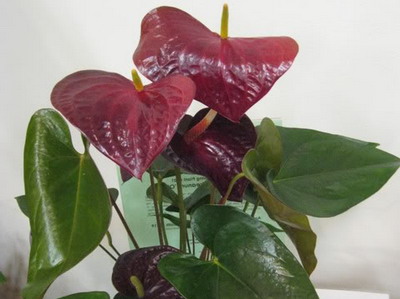
Aglaonema – transplant
As a rule, aglaonema transplantation of young specimens is carried out annually, and adults (over 3 years old) 1 time in 2-3 years in the spring. It is necessary to transplant into a deep pot with a kidney consisting of peat, sand, leafy and soddy soil in a ratio of 1:1:1:2. It is advisable to add 3-5% of the volume of brick chips and charcoal. The plant grows and blooms best in a tight pot. The first 4-6 months after transplantation does not need additional feeding.
Aglaonema: pests and diseases
Spider mite – when the air is too dry, cobwebs appear on the stems of the plant, and the leaves wither and fall off. Control measures: wipe the plant with a soapy sponge and wash it under a warm shower, and in case of severe damage, spray with a 0.15% Actellic solution.
Mealybug – affects young shoots and leaves. The leaves dry, bend, fall off and the plant dies. Control measures: the same as in the case of spider mites.
Aphid – damages the leaves from the underside and tops of the shoots. The leaves turn yellow, curl and fall, and the tops of the shoots become discolored. Control measures: spray with fitoverm, decis, derris, actellik, inta-vir. And in case of severe damage, repeat the procedure several times.
Pest gray rot – occurs when the temperature is too low, poor ventilation and excessive humidity. A sign is the appearance of a gray coating on the surface of the leaves.







